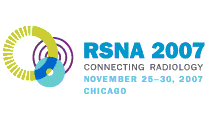
Abstract Archives of the RSNA, 2007
LL-MK4160-R06
Sonographic Assessment of Supramalleolar Posterior Tibial Tendon Injuries and Associated Findings
Scientific Posters
Presented on November 29, 2007
Presented as part of LL-MK-R: Musculoskeletal
Thomas Howard Grant DO, Abstract Co-Author: Nothing to Disclose
Imran Muhammad Omar MD, Presenter: Nothing to Disclose
Supramalleolar injuries of the posterior tibial tendon (PTT) may relect a different patient population from those with inframalleolar tendinopathy. We noted a number of patients with supramalleolar PTT tendinopathy had associated flexor retinaculum abnormalities not often seen in patients with inframalleolar tendinopathy. We sought to characterize the populations of patients with supramalleolar and inframalleolar tendinopathy, and assess for associated findings such as retinacular pathology.
223 sonographic studies of 214 consecutive patients (both PTTs were assessed in 9 patients) over a 2-year period for assessment of the PTT were retrospectively reviewed by two musculoskeletal sonologists in concensus, recording the patient age and gender, degree of PTT injury, location along the tendon, presence of tendon subluxation/dislocation, and flexor retinaculum appearance.
22 of 223 studies had supramalleolar tendinopathy, while 99 had inframalleolar tendinopathy. The PTT was normal in 113 studies. The mean age of the patients with supramalleolar tendinopathy was 46.3 yrs(18 to 60 yrs,15:7 M:F), and 53.4 yrs in the inframlleolar group(15 to 81 yrs,32:61 M:F). Of the supramalleolar teninopathy group 3 were completely dislocated and 4 were subluxated. Tenosynovitis was seen in 27 studies with inframalleolar tendinopathy and 2 with supramalleolar tendinopathy. In the supramalleolar group grade 1 tendinopathy was seen in 10 patient; grade 2 tendinopathy had 5 and there were 2 complete (grade 3) tears. 15 of 22 also demonstrated retinacular thickening. In the inframalleolar group 53 patients demonstrated grade 1 tendinosis, 42 demonstrated grade 2 tendinosis and 4 demonstrated grade 3 tendinosis. Retinacular thickening was seen in 1 patient.
Patients with supramalleolar PTT tendinopathy tend to be male and younger compared to those with inframalleolar tendinopathy. The PTTs in these patients were often dislocated or subluxated, and associated with flexor retinacular injuries.
Supramalleolar PTT injuries are more likely related to acute trauma than repetitive injury and are frequently associated with flexor retinaculum injuries and tendon subluxation/dislocation.
Grant, T,
Omar, I,
Sonographic Assessment of Supramalleolar Posterior Tibial Tendon Injuries and Associated Findings. Radiological Society of North America 2007 Scientific Assembly and Annual Meeting, November 25 - November 30, 2007 ,Chicago IL.
http://archive.rsna.org/2007/5016728.html
Accessed November 10, 2025

